Jane Aitken
Jane Aitken (July 11, 1764 – August 29, 1832) was an early American printer, publisher, bookbinder, and bookseller. She was born in Scotland and her family immigrated to America with several compatriots in 1771. She ran a print shop and bookstore in downtown Philadelphia in the early 1800s. She received her training in the printing and book merchandising business from her father. Bookbinding was a major portion of her income.
Jane Aitken | |
|---|---|
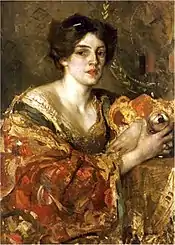 | |
| Born | July 11, 1764 |
| Died | August 29, 1832 (aged 68) |
| Occupation | Printer, bookbinder |
| Parent(s) | Robert Aitken, Janet Skeoch |
Aitken printed and bound dozens of books for the Athenaeum of Philadelphia and about 400 volumes for the American Philosophical Society. She was a friend of wine merchant John Vaughan, a long-time treasurer and librarian of the American Philosophical Society. She was the first woman in the United States to print an English translation version of the Christian Bible.
Early life
Aitken was born in Paisley, Scotland, on July 11, 1764.[1] Her father was Robert Aitken (1734–1802), a Scottish stationery and book merchant who later became a Philadelphia printer and bookbinder.[2] Her mother's maiden name was Janet Skeoch. She was the first of four children (two girls and two boys) that grew to adulthood in the family. Aitken and her family were among several Scottish families that emigrated to Colonial America in 1771.[3] The Aitken family settled in Philadelphia, their port of arrival.[3]
Mid life and business career
Aitken was involved with her father's Philadelphia publishing business located at his two-story brick house, which consisted of a print shop and bindery sideline at 22 Market Street.[1][3] Her handwritten bookkeeping shows the print shop printed a newspaper, journals, books, and stationery.[3] She inherited the printing business from her father's estate after his death in 1802 when she was thirty-eight years old.[1][2] The property itself had been sold in 1800 by her father, but the business continued until his death.[4]
The printing and publications were thereafter in her own name as Printed by Jane Aitken from her print shop and bindery, which she ran at North Third Street in Philadelphia.[5] Her first location on the street shows in a 1803 newspaper notice as being at number 20, which was 500 feet (150 m) away from her father's house. At that time, with her sister Mary Ann Campbell, she was an administratrix to settle her brother-in-law's estate.[6] Another 1803 newspaper report five months later shows her at being at number 20 North Third Street.[7] Miss Jane Aitken's Bookstore shows her address at number 62 in an 1807 advertisement selling tickets to a lecture.[8] The following year her print shop was advertising a book on agriculture and A statistical account of the Schuylkill Permanent Bridge, with her bookstore being located at number 71 North Third Street.[9]
Aitken's father's estate came with a heavy debt that was incurred from mortgage notes he had signed for when he borrowed money and used his business as security.[10] The debt was $3,000 (equivalent to $57,000 in 2021).[11] Her brother, Robert Aitken Jr., who was a year younger than she and had been disowned by their father, was financially incapable to assist in this debt.[10] Aitken, being the oldest child, assumed the responsibility of caring for her two younger sisters, as her mother had previously died.[11] She never married and was always known as Miss Jane Aitken.[1]
Aitken's bookbinding business gave more support to the family than the printing part of the business.[11] She bound dozens of the volumes she printed up for the Athenaeum of Philadelphia and about 400 volumes for the American Philosophical Society.[3] Historian Carol M. Spawn says that the binding work of 1802 to 1812 shows similarity to her binding work from when she was younger working from her father's shop.[12] She advertised for an assistant journeyman bookbinder in October and November 1812 to help her at the 71 North Third Street location.[13]
Later life and death
John Vaughan, a friend of Aitken and a librarian from the American Philosophical Society, gave her much work and even some financial assistance, but her business failed in 1813 and her equipment was sold.[2] Vaughan bought the equipment at a sheriff's sale and rented it back to her at under the going market rate, however after she failed again in 1814, she was put into debtors' prison at the Norristown Jail, 20 miles (32 km) outside Philadelphia.[14] She retired from the printing business in 1815.[15]
There are few historical records from then other than the "late printer" when her death record of 1832 appears in an obituary in Germantown, Pennsylvania. The obituary shows she had a long and agonizing illness before dying on August 29, 1832.[1][16] Her burial place is assumed to be in the destroyed cemetery of the Associate Reformed Presbyterian Church in Philadelphia, of which she was a member.[14]
Works
Aitken published at least sixty works from 1802 to 1812. One of her extensive printings was The Census Directory for 1811 of the third United States census for the city of Philadelphia.[17]
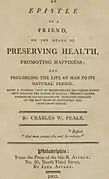 An epistle to a friend, on the means of Preserving Health(1803)
An epistle to a friend, on the means of Preserving Health(1803) The constitution of the Female Association of Philadelphia ...(1803)
The constitution of the Female Association of Philadelphia ...(1803)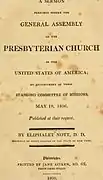 Sermon preached before the General Assembly of Presbyterian Church (1806)
Sermon preached before the General Assembly of Presbyterian Church (1806)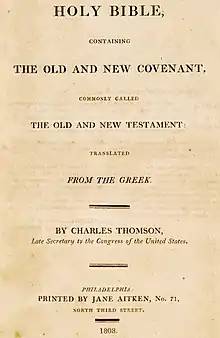 Thomson Holy Bible containing
Thomson Holy Bible containing
The Old and New Covenant. (1808)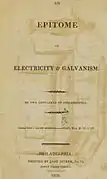 Epitome of electricity galvanism (1809)
Epitome of electricity galvanism (1809)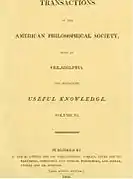 American Philosophical Society (1809)
American Philosophical Society (1809)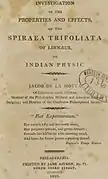 Spiraea trifoliata Linnaeus (1810)
Spiraea trifoliata Linnaeus (1810)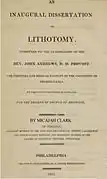 Inaugural dissertation on lithotomy (1811)
Inaugural dissertation on lithotomy (1811)
Legacy
Aitken was the first woman in the United States to print an English translation version of the Christian Bible.[18][19] This 1808 work is known as Thomson's Bible, being translated by the patriot revolutionary leader Charles Thomson.[2][10][11] Historian June Melby Benowitz says that this four-volume publication was the most important book which she produced during her career.[1] A search conducted in 1930 by the National Federation of Business and Professional Women determined that Aitken in 1808 became the first American businesswoman.[20]
See also
Footnotes
- Benowitz 1998, p. 6.
- Read & Witlieb 1992, p. 13.
- James 1971, p. 26.
- "A two-story Brick House". The Philadelphia Inquirer. Philadelphia, Pennsylvania. December 29, 1800. p. 2. Retrieved September 6, 2021 – via Newspapers.com
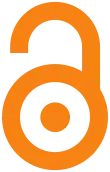 .
. - Harley 1900, p. 166.
- "Notice". Aurora General Advertiser. Philadelphia, Pennsylvania. April 16, 1803. p. 1. Retrieved September 6, 2021 – via Newspapers.com
 .
. - "A Report". Aurora General Advertiser. Philadelphia, Pennsylvania. September 2, 1803. p. 3. Retrieved September 6, 2021 – via Newspapers.com
 .
. - "The Ladies & Gentlemen of Philadelphia". Aurora General Advertiser. Philadelphia, Pennsylvania. February 10, 1807. p. 1. Retrieved September 6, 2021 – via Newspapers.com
 .
. - "Agricultural Memoirs". Aurora General Advertiser. Philadelphia, Pennsylvania. July 2, 1808. p. 1. Retrieved September 6, 2021 – via Newspapers.com
 .
. - Krismann 2005, p. 20.
- Appleby 2002, p. 41.
- James 1971, p. 27.
- "Wanted Immediately". Aurora General Advertiser. Philadelphia, Pennsylvania. November 7, 1812. p. 1. Retrieved September 6, 2021 – via Newspapers.com
 .
. - James 1971, p. 28.
- Sherrow 2002, p. 3.
- Appleby 2002, p. 42.
- "Census Directory for 1811". Aurora General Advertiser. Philadelphia, Pennsylvania. January 22, 1811. p. 3. Retrieved September 6, 2021 – via Newspapers.com
 .
. - Kane 1997, p. 85, item 1966..
- Sherrow 2002, p. 2.
- "First Business Woman was a printer of books". The Sacramento Bee. Sacramento, California. December 12, 1930. p. 33. Retrieved September 6, 2021 – via Newspapers.com
 .
.
Bibliography
- Appleby, Joyce Oldham (2002). Encyclopedia of Women in American History: Civil War, western expansion, and industrialization, 1820–1900. Sharpe Reference. ISBN 978-0-765-68038-9.
- Benowitz, June Melby (1998). Encyclopedia of American Women and Religion. ABC-CLIO. ISBN 978-0-87436-887-1.
- Harley, Lewis R. (1900). The Life of Charles Thompson. G.W. Jacobs & Company. OCLC 27362028.
- James, Edward T. (1971). Notable American Women, 1607–1950: A Biographical Dictionary. Harvard University Press. ISBN 978-0-674-62734-5.
- Kane, Joseph Nathan (1997). Famous First Facts: a record of first happenings, discoveries and inventions in the United States. New York: H. W. Wilson Company. ISBN 0-8242-0930-3.
- Krismann, Carol (2005). Encyclopedia of American Women in Business: A–L. Greenwood Publishing Group. p. 20. ISBN 978-0-313-33383-5.
- Read, Phyllis J.; Witlieb, Bernard L. (1992). The Book of Women's Firsts. Random House Information Group. ISBN 978-0-679-40975-5.
- Sherrow, Victoria (2002). American Women Business Entrepreneurs. Facts On File, Incorporated. ISBN 978-0-8160-4556-3.